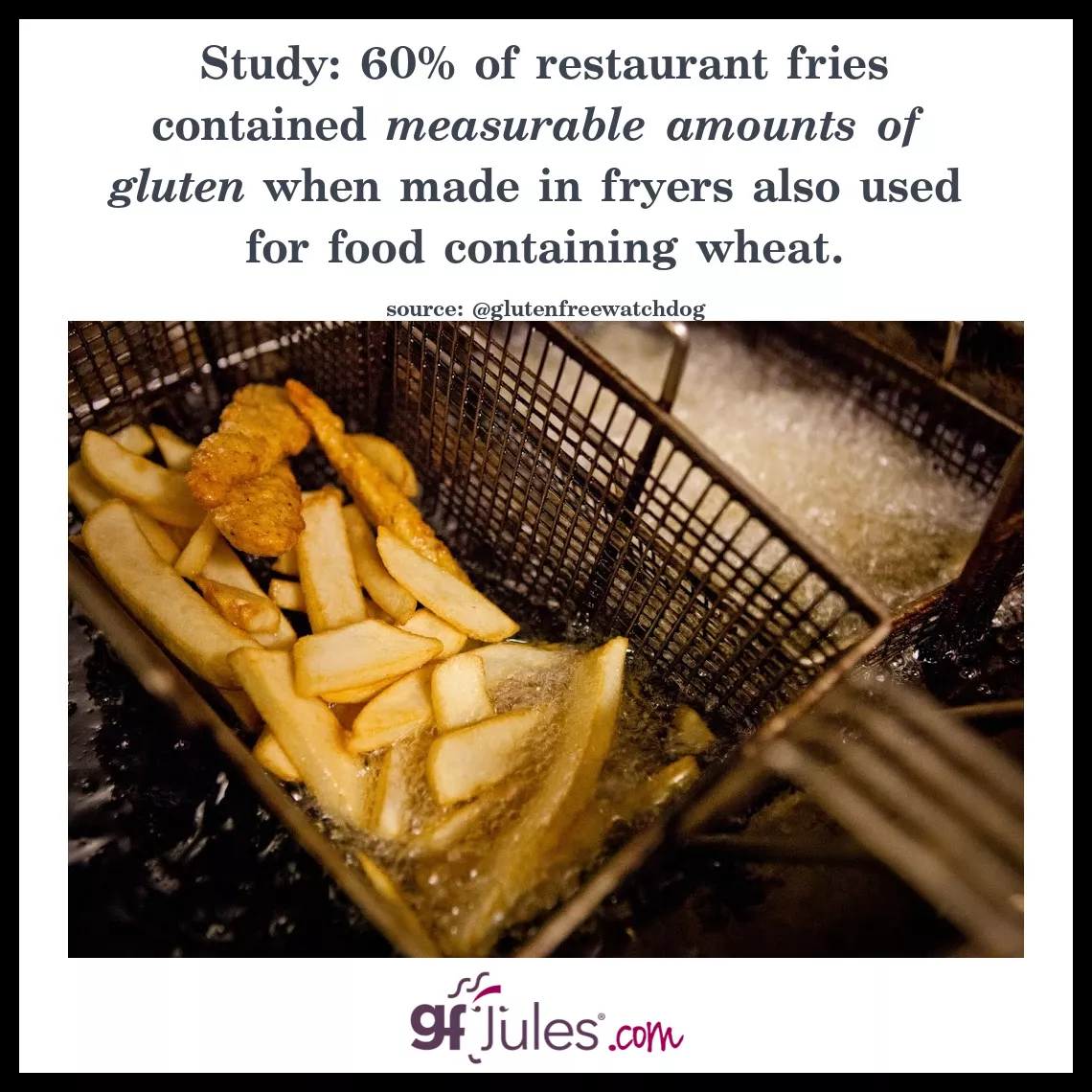If you eat gluten free, you’ve very likely wondered if you can dine out at — or order in from — restaurants again safely. Which restaurants are more likely to be safe and how to ensure the best experience possible are the real questions. For that, I have 8 top tips!
 I’ve updated an excerpted portion of the chapter “Dining Out Again – Safely and Enjoyably,” from my book, The First Year: Celiac Disease and Living Gluten Free. If you have anything to add about your own experiences eating gluten free at restaurants, good or bad, please share in the comments!
I’ve updated an excerpted portion of the chapter “Dining Out Again – Safely and Enjoyably,” from my book, The First Year: Celiac Disease and Living Gluten Free. If you have anything to add about your own experiences eating gluten free at restaurants, good or bad, please share in the comments!
For more information on the differences between gluten-free menus, gluten-free menu offerings at places like gluten-free pizza chains, and truly gluten-free restaurant options, definitely check out my article on Safe Gluten Free Shopping & Eating Out.
When asked if I eat out from restaurants now that I have celiac disease, I answer “Yes, but …” only with the proper planning and in the right places. AND I have lots of advice on how to do so intelligently and safely:
Before you were diagnosed with celiac disease or gluten sensitivity, running out to grab a quick bite to eat where someone else had to do the cooking and cleaning up was a luxury you may not have fully appreciated. Now that you have some idea of the hazards of eating gluten, you may feel too frightened to leave the confines of your own (now) gluten-free kitchen.

A study of Canadians living with celiac disease reported that more than half of the families with celiac members reported that they avoided restaurants all or most of the time, despite the fact that four out of five people generally report that going out to eat at a restaurant is a better way to use their leisure time than cooking and cleaning up!

But living gluten free is not about living in a bubble, so I urge you to put your fears on the shelf of your gluten-free flour cupboard and close the door!
Since most celiacs surveyed (and really, who doesn’t agree with this statement at least once in awhile?) have indicated that their quality of life would be improved if there were more gluten-free choices at restaurants, it is imperative that you learn how to successfully navigate the restaurant world as a gluten-free’er wanting to live a better life.
There is a way to safely go back out again and socialize, entertain, “do business lunches”, go on dinner dates, and grab a meal at a local joint — even socially distanced or take-out. You just have to know how to do it!
Before you run back out to McDonald’s, though, a few important pointers are useful.
Top 8 Tips for Eating Out Safely Gluten Free:
1. Try to eat early or late
… so that you avoid the rush hours when the managers and chefs have the least time to pay special attention to your meal. And you should note that I’m urging you to find the manager or chef to help you with your order so that you can be sure it’s attended to properly!
Also, wherever possible, patronize restaurants that make their food from scratch.
I know it’s not always easy to do, and I know that those restaurants are likely to be more expensive, but they will have a much better grip on what their ingredients are. Besides, aren’t you worth it? Your health certainly is!
2. Understand the limitations of larger restaurants and fast-food chains.
They work with pre-made sauces and ingredients, have line cooks preparing different parts of the same meal, usually have unseasoned staff (pun intended) and cross-contact is often hard to avoid. Restaurants which make their own bread or use flour in recipes (pizza, battered & fried food, bakery items, etc.) are also less likely to be able to ensure your dish is free from gluten.
As a rule, it’s wise to avoid most fast food, as there’s just too much going on in a small environment to ensure your food stays safe, but there are always exceptions. Chick-fil-A, for example, offers grilled nuggets and fries prepared in a dedicated fryer (always double check at each outlet though, and alert them to your dietary restriction).
No matter what the size of the restaurant, be sure to patronize restaurants doing a good job whenever possible to encourage them to continue gluten-free offerings and to relieve your own mind about your meal.

3. When possible, call ahead during less busy times
… and ask questions about the menu and alert the chef of your needs. When you arrive at the restaurant, use these printable “restaurant cards” to minimize misunderstandings between you and the kitchen.
Waiters love these cards because they don’t have to write all of your ingredient restrictions down and they are absolved of responsibility when they can hand the cards to the kitchen. The kitchen staff appreciates the cards because they are not left in the dark as to the parameters of your food restrictions. And you’ll love the cards because they make your life a lot easier and safer.
As long as there is good communication between you and the kitchen, you should feel more comfortable with your entire dining experience. Also be sure to tip your server well – it never hurts to reward and incentivize servers for your next visit!

4. Establish a relationship with the manager or owner of local restaurants
… you particularly enjoy. Maybe it’s the neighborhood Mexican restaurant or a take-out Thai place you have always loved, or even a chain restaurant that is close to work and your colleagues love to frequent.
Introduce yourself sometime and educate the proprietor about your food restrictions in the kindest possible way. Offer to go over the menu items with him or her (during off-peak hours!) and to identify what is already gluten-free so that they can let other patrons know about safe choices.
Ask if you could make arrangements to bring your own gluten-free pasta and have the chef boil it for you in a separate pot, but serve his or her recommended (gluten-free) sauces.
Volunteer to let the local celiac support group know of this restaurant’s cooperation and drum up support for the establishment. Get creative and by all means, be nice! You may even be surprised at how eager they are to please you when you become a regular and are greeted at the door like Norm in “Cheers.”
5. Get to know the fryer and BYOC (Bring Your Own Chips).
It is easy to believe that the fries are gluten-free because potatoes are on your safe list. However, restaurants often have only one fryer, and once your French fries have been deep fried in the oil they also used to fry the chicken nuggets, well, I hate to break it to you, but your fries are no longer gluten-free.
FACT: In a shared fryer, bits of wheat batter will break off and find their way onto your gluten-free fries or chips, as gluten-free blogger Johnna found recently. But even if you don’t actually see it, cross-contact can still do damage to someone with celiac disease or cause problems for someone with gluten sensitivity.

A study done by Gluten Free Watchdog in 2020 found cross contact with gluten when gluten-free foods were cooked in shared fryers with wheat. Also, if they recycle their oil, even a dedicated fryer may not protect you from cross-contact.
Furthermore, even if their fryer is not cross-contaminated from other food items, the French fries may themselves not be gluten-free! McDonald’s famous French fries are a perfect example. Their website has from time to time indicated that their fries are free from wheat and gluten; however, numerous lawsuits have alleged that the food allergy listing on the site is incorrect and misleading.
 Due to these lawsuits, the website (page 18) was updated to indicate that the vegetable oil in which the fries are cooked actually contains beef flavor derived from wheat and milk (along with 17 other ingredients … to make a french fry?! No thank you!).
Due to these lawsuits, the website (page 18) was updated to indicate that the vegetable oil in which the fries are cooked actually contains beef flavor derived from wheat and milk (along with 17 other ingredients … to make a french fry?! No thank you!).
Current (2022) ingredient list for McDonald’s fries themselves (and no, it’s apparently not just potatoes):
French Fries: Potatoes, Vegetable Oil (canola Oil, Corn Oil, Soybean Oil, Hydrogenated Soybean Oil, Natural Beef Flavor [wheat And Milk Derivatives]*), Dextrose, Sodium Acid Pyrophosphate (maintain Color), Salt. *natural Beef Flavor Contains Hydrolyzed Wheat And Hydrolyzed Milk As Starting Ingredients.
Contains: Wheat, Milk.

Thus, seemingly gluten-free items (potatoes + vegetable oil) may still contain gluten—it never hurts to check.
By the way, there are restaurants like Chick-fil-A which do typically use a dedicated GF fryer for their french fries, but always ask before ordering at each store!

Tortilla chips are another big no-no if they are made in a fryer that also fries flour products or breaded items. If you’re unsure, bring your own! I usually bring my own gluten-free crackers or chips to any Mexican restaurant, just to be on the safe side. BYOC (Bring Your Own Chips!!!!!)
If others at the table are dipping the restaurant chips into the salsa or guacamole, ask for a separate bowl so you can be certain there’s no cross-contact. In fact, I often bring my own (fill in the blank) food when I must eat at a restaurant where, for one reason or another, I do not feel safe eating their food.
I want to be social, but not at the expense of my health. (This is a great thing to do for social distancing anyway, so ….)

I’ve never run into issues with bringing in food myself, but if you do, that’s certainly an establishment that does not deserve your business, or the business of those with whom you are dining. When I consult with restaurateurs who wonder if they should care about patrons who have dietary restrictions like gluten, I always remind them that very few people dine alone.
In other words, one gluten-free diner might not seem like a big deal, but their party from the office or the rest of their family or the girls’ night out crew IS a big deal; if the gluten-free person can’t eat there, no one else in their party will either.

6. While you’re at it, ask that your food be prepared on aluminum foil.
Whether you order a grilled steak or a sautéed fish, ask that the chef place foil under your food. This request does three things in addition to actually protecting against cross-contact.
First, it brings attention to the fact that gluten-containing food may have been on that grill first. Second, it causes the cook to actually stop to consider whether he or she is using a clean pan to flash fry your fillet. Third, it ensures that the kitchen will take your food restriction much more seriously.

7. Avoid cafeterias, salad bars and buffets.
Not that I harbor any childhood resentment from being forced to eat lime Jell-o, succotash, corn pudding, fried catfish and a yeast roll (all on the same plate), but you get my point. It doesn’t matter here if the kitchen can somehow avoid cross-contact, the line probably can’t.
The same serving spoon that was in that corn pudding will likely find its way into your steamed vegetables at some point. It’s a sad truth, but no less truthful. By the same token, salad bars which have any gluten on them (think croutons, fake crab meat, and the like) are also risky, since patrons help themselves and often transfer spoons or drip one food onto another.

8. Thank all those at the restaurant who were helpful and attentive, and be sure to leave a generous tip.
This gratitude will come back in spades, at this and other restaurants, for you and for other diners with food restrictions.
. . . .
Bottom line: you don’t necessarily have to give up on dining out— you can work with restaurant personnel before and during meals, and you may even enjoy safe fast food experiences when you know what to look for and consciously avoid cross-contact.
If you do not feel safe eating the food prepared at a restaurant, however, do not take a chance. Your health is too important!
I always have a gluten free protein bar or a bag of nuts in my purse for just such an occasion. Be prepared, be cautious and be real. Even if you can’t eat at a restaurant, you could still go and enjoy a drink or the foods you brought in yourself.
 Excerpted and updated from my second book,
Excerpted and updated from my second book,
The First Year: Celiac Disease and Living Gluten Free (Da Capo Press, 2008).
Did you like these tips? Pin them to refer back to later!









 (3 votes, average: 4.33 out of 5)
(3 votes, average: 4.33 out of 5)















